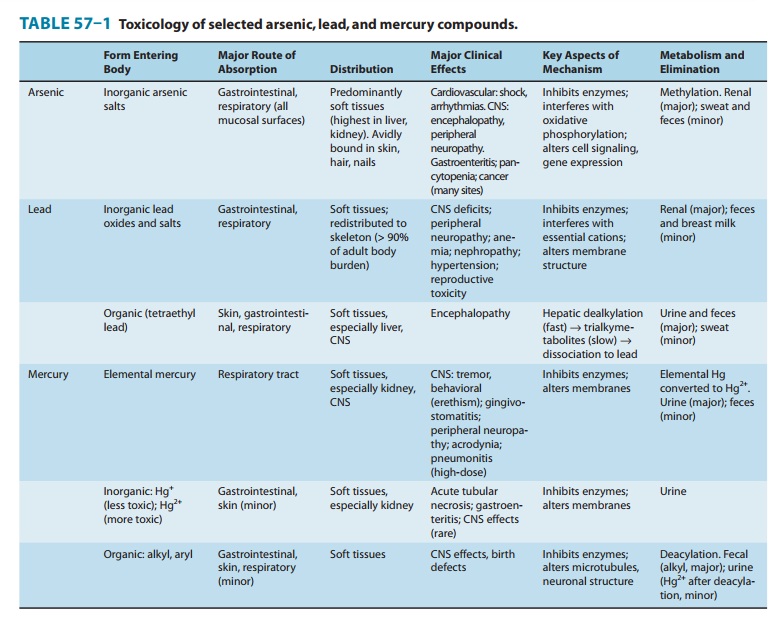Chapter: Basic & Clinical Pharmacology : Heavy Metal Intoxication & Chelators
Major Forms of Arsenic Intoxication
Major Forms of Arsenic
Intoxication
A. Acute Inorganic Arsenic Poisoning
Within minutes to
hours after exposure to high doses (tens to hundreds of milligrams) of soluble
inorganic arsenic compounds, many systems are affected. Initial
gastrointestinal signs and symp-toms include nausea, vomiting, diarrhea, and
abdominal pain. Diffuse capillary leak, combined with gastrointestinal fluid
loss, may result in hypotension, shock, and death. Cardiopulmonary toxicity,
including congestive cardiomyopathy, cardiogenic or noncardiogenic pulmonary
edema, and ventricular arrhythmias, may occur promptly or after a delay of
several days. Pancytopenia usually develops within 1 week, and basophilic
stippling of eryth-rocytes may be present soon after. Central nervous system
effects, including delirium, encephalopathy, and coma, may occur within the
first few days of intoxication. An ascending sensorimotor peripheral neuropathy
may begin to develop after a delay of 2–6 weeks. This neuropathy may ultimately
involve the proximal musculature and result in neuromuscular respiratory
failure. Months after an acute poisoning, transverse white striae (Aldrich-Mees
lines) may be visible in the nails.
Acute inorganic
arsenic poisoning should be considered in an individual presenting with abrupt
onset of gastroenteritis in com-bination with hypotension and metabolic
acidosis. Suspicion should be further heightened when these initial findings
are fol-lowed by cardiac dysfunction, pancytopenia, and peripheral neu-ropathy.
The diagnosis may be confirmed by demonstration of elevated amounts of
inorganic arsenic and its metabolites in the urine (typically in the range of
several thousand micrograms in the first 2–3 days after acute symptomatic
poisoning). Arsenic disap-pears rapidly from the blood, and except in anuric
patients, blood arsenic levels should not be used for diagnostic purposes.
Treatment is based on appropriate gut decontamination, intensivesupportive
care, and prompt chelation with unithiol,
3–5 mg/kg intravenously every 4–6 hours, or dimercaprol, 3–5 mg/kg intra-muscularly every 4–6 hours. In animal
studies, the efficacy of chelation has been highest when it is administered
within minutes to hours after arsenic exposure; therefore, if diagnostic
suspi-cion is high, treatment should not be withheld for the several days to
weeks often required to obtain laboratory confirmation.
Succimer
has also been effective in animal models and has a higher therapeutic index
than dimercaprol. However, because it is available in the United States only
for oral administration, its use may not be advisable in the initial treatment
of acute arsenic poi-soning, when severe gastroenteritis and splanchnic edema
may limit absorption by this route.
B. Chronic Inorganic Arsenic Poisoning
Chronic inorganic
arsenic poisoning also results in multisystemic signs and symptoms. Overt
noncarcinogenic effects may be evi-dent after chronic absorption of more than
0.01 mg/kg/d (∼ 500–1000 mcg/d in
adults). The time to appearance of symp-toms varies with dose and
interindividual tolerance. Constitutional symptoms of fatigue, weight loss, and
weakness may be present, along with anemia, nonspecific gastrointestinal
complaints, and a sensorimotor peripheral neuropathy, particularly featuring a
stocking glove pattern of dysesthesia. Skin changes—among the most
characteristic effects—typically develop after years of expo-sure and include a
“raindrop” pattern of hyperpigmentation, and hyperkeratoses involving the hands
and feet (Figure 57–1). Peripheral vascular disease and noncirrhotic portal
hypertension may also occur. Epidemiologic studies suggest a possible link to
hypertension, diabetes, chronic nonmalignant respiratory disease, and adverse
reproductive outcomes. Cancer of the lung, skin, bladder, and possibly other
sites, may appear years after exposure to doses of arsenic that are not high
enough to elicit other acute or chronic effects.

Administration
of arsenite in cancer chemotherapy regimens, often at a daily dose of 10–20 mg
for weeks to a few months, has been associated with prolongation of the QT
interval on the elec-trocardiogram and occasionally has resulted in malignant
ventric-ular arrhythmias such as torsades de pointes.
The diagnosis of chronic arsenic poisoning involves inte-gration of the clinical findings with confirmation of exposure. The urine concentration of the sum of inorganic arsenic and its primary metabolites MMA and DMA is less than 20 mcg/L in the general population. High urine levels associated with overt adverse effects may return to normal within days to weeks after exposure ceases. Because it may contain large amounts of nontoxic organoarsenic, all seafood should be avoided for at least 3 days before submission of a urine sample for diagnostic purposes. The arsenic content of hair and nails (normally less than 1 ppm) may sometimes reveal past elevated exposure, but results should be interpreted cautiously in view of the potential for external contamination.
Management of chronic arsenic poisoning consists primarily of termination of exposure and nonspecific supportive care. Although empiric
short-term oral chelation with unithiol
or succimer for symptomatic
individuals with elevated urine arsenic concentra-tions may be considered, it
has no proven benefit beyond removal from exposure alone. Preliminary studies
suggest that dietary supplementation of folate—thought to be a cofactor in
arsenic methylation—might be of value in arsenic-exposed individuals,
particularly men, who are also deficient in folate.
C. Arsine Gas Poisoning
Arsine gas poisoning
produces a distinctive pattern of intoxication dominated by profound hemolytic
effects. After a latent period that may range from 2 hours to 24 hours
postinhalation (depend-ing on the magnitude of exposure), massive intravascular
hemoly-sis may occur. Initial symptoms may include malaise, headache, dyspnea,
weakness, nausea, vomiting, abdominal pain, jaundice, and hemoglobinuria.
Oliguric renal failure, a consequence of hemoglobin deposition in the renal
tubules, often appears within 1–3 days. In massive exposures, lethal effects on
cellular respira-tion may occur before renal failure develops. Urinary arsenic
levels are elevated but are seldom available to confirm the diagnosis dur-ing
the critical period of illness. Intensive supportive care— including exchange
transfusion, vigorous hydration, and, in the case of acute renal failure,
hemodialysis—is the mainstay of therapy.Currently available chelating agents
have not been demonstrated to be of clinical value in arsine poisoning.
Related Topics